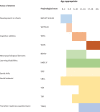Care of girls and women with Turner syndrome: beyond growth and hormones
- PMID: 28336768
- PMCID: PMC5434744
- DOI: 10.1530/EC-17-0036
Care of girls and women with Turner syndrome: beyond growth and hormones
Abstract
Turner syndrome (TS), although considered a rare disease, is the most common sex chromosome abnormality in women, with an incident of 1 in 2500 female births. TS is characterized by distinctive physical features such as short stature, ovarian dysgenesis, an increased risk for heart and renal defects as well as a specific cognitive and psychosocial phenotype. Given the complexity of the condition, patients face manifold difficulties which increase over the lifespan. Furthermore, failures during the transitional phase to adult care result in moderate health outcomes and decreased quality of life. Guidelines on the optimal screening procedures and medical treatment are easy to find. However, recommendations for the treatment of the incriminating psychosocial aspects in TS are scarce. In this work, we first reviewed the literature on the cognitive and psychosocial development of girls with TS compared with normal development, from disclosure to young adulthood, and then introduce a psychosocial approach to counseling and treating patients with TS, including recommendations for age-appropriate psychological diagnostics. With this work, we aim to facilitate the integration of emphasized psychosocial care in state-of-the-art treatment for girls and women with TS.
Keywords: cognitive profile; development in Turner syndrome; health autonomy; psychological approach; psychosocial care in endocrinology; psychosocial recommendations in peadiatrics; transition in endocrinological care; x-linked.
© 2017 The authors.
Figures
Similar articles
-
Transition from pediatric to adult care in patients with Turner syndrome in Italy: a consensus statement by the TRAMITI project.J Endocrinol Invest. 2024 Jul;47(7):1585-1598. doi: 10.1007/s40618-024-02315-4. Epub 2024 Feb 20. J Endocrinol Invest. 2024. PMID: 38376731 Free PMC article.
-
Turner syndrome and clinical treatment.Br Med Bull. 2008;86:77-93. doi: 10.1093/bmb/ldn015. Epub 2008 Apr 9. Br Med Bull. 2008. PMID: 18400842 Review.
-
[Rapidly progressive puberty in a patient with mosaic Turner syndrome: a case report and literature review].Zhonghua Er Ke Za Zhi. 2017 Feb 2;55(2):125-130. doi: 10.3760/cma.j.issn.0578-1310.2017.02.014. Zhonghua Er Ke Za Zhi. 2017. PMID: 28173651 Review. Chinese.
-
Psychosocial well-being and quality of life in women with Turner syndrome.Psychoneuroendocrinology. 2020 Mar;113:104548. doi: 10.1016/j.psyneuen.2019.104548. Epub 2019 Dec 23. Psychoneuroendocrinology. 2020. PMID: 31923612
-
Psychosocial functioning after discontinuation of long-term growth hormone treatment in girls with Turner syndrome.Horm Res. 2005;63(5):238-44. doi: 10.1159/000085841. Epub 2005 May 17. Horm Res. 2005. PMID: 15900109 Clinical Trial.
Cited by
-
The importance of genetic counselling for turner syndrome transition.Eur Child Adolesc Psychiatry. 2025 Mar;34(3):943-958. doi: 10.1007/s00787-024-02547-y. Epub 2024 Aug 8. Eur Child Adolesc Psychiatry. 2025. PMID: 39115686 Review.
-
Turner Syndrome where are we?Orphanet J Rare Dis. 2024 Aug 28;19(1):314. doi: 10.1186/s13023-024-03337-0. Orphanet J Rare Dis. 2024. PMID: 39198906 Free PMC article. Review.
-
Time to consider ovarian tissue cryopreservation for girls with Turner's syndrome: an opinion paper.Hum Reprod Open. 2019 Jun 20;2019(3):hoz016. doi: 10.1093/hropen/hoz016. eCollection 2019. Hum Reprod Open. 2019. PMID: 31240242 Free PMC article.
-
Neurocognitive and psychosocial profiles of children with Turner syndrome.Ann Pediatr Endocrinol Metab. 2023 Dec;28(4):258-266. doi: 10.6065/apem.2244222.111. Epub 2023 Feb 5. Ann Pediatr Endocrinol Metab. 2023. PMID: 36758969 Free PMC article.
-
Growth Hormone Supplementation and Psychosocial Functioning to Adult Height in Turner Syndrome: A Questionnaire Study of Participants in the Canadian Randomized Trial.Front Endocrinol (Lausanne). 2019 Mar 13;10:125. doi: 10.3389/fendo.2019.00125. eCollection 2019. Front Endocrinol (Lausanne). 2019. PMID: 30930850 Free PMC article.
References
Publication types
LinkOut - more resources
Full Text Sources
Other Literature Sources



